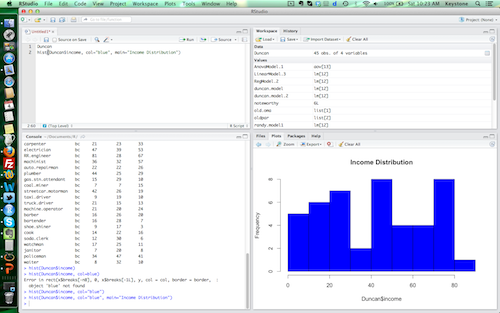Despite my preference for SAS over R, there are some add-ons to “basic” R that I’ve found that have made my learning process way easier. While I’m still in my infancy in learning R, I feel like once I found these additional tools, my ability to use R to get work done improved significantly.
In this first post of three, I’ll discuss RStudio, a more friendly access point to the default installation of R. My second post will discuss Rcmdr, a GUI developed for students taking a basic college-level course in Statistics. The third post will cover rattle, a GUI specifically designed for data mining (as opposed to more general statistics like Rcmdr).
RStudio

R Studio is an IDE that dramatically improves the R experience
RStudio is an open-source Integrated Development Environment (IDE) that provides a more consistent user experience to R. There are many great features of RStudio over “basic” R, including:
- Consistent windowing between sessions (customizable by the user)
- Point-and-click exploration of data frames and other data objects
- Importing data files through dialog box functionality
- Customizable code syntax highlighting, auto-complete, and Help menu access from the code editor
- Ability to see all installed packages, turn on packages using a checkbox, and download libraries (and their dependencies) without having to write any code
- Version Control using GitHub
While RStudio doesn’t provide a GUI that will help you run a regression model or build a graph, it provides a more “friendly” environment to work in as compared to the command-line interface of a default installation of R. I find that by having elements like the currently active data objects and available/active packages with links to the Help files “exposed” at all times, RStudio reminds me of where my analysis has been and gives me a quick way to think about “What Else?” to pursue if I hit a roadblock.
Installation of RStudio
RStudio installs like any other program for Windows or Mac OSX. As far as I can tell, there are no advantages to using RStudio in either environment, both the Windows and OSX versions seem to work equally well. The most important consideration is that RStudio is just an “add-on” so-to-speak, it does not include R itself. So be sure to go to one of the Comprehensive R Archive Network (CRAN) sites to download R first.